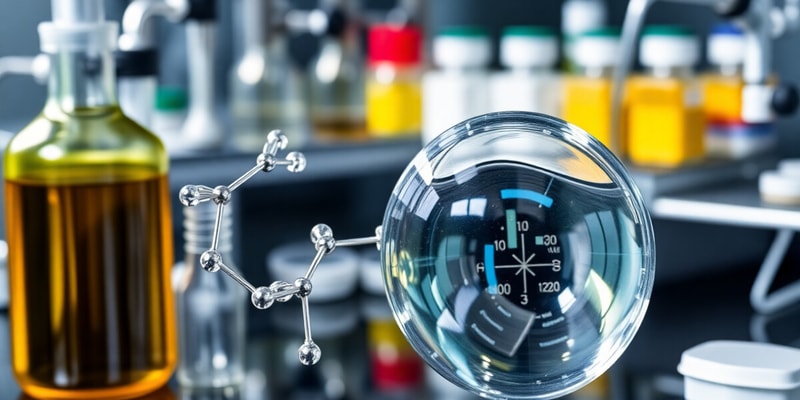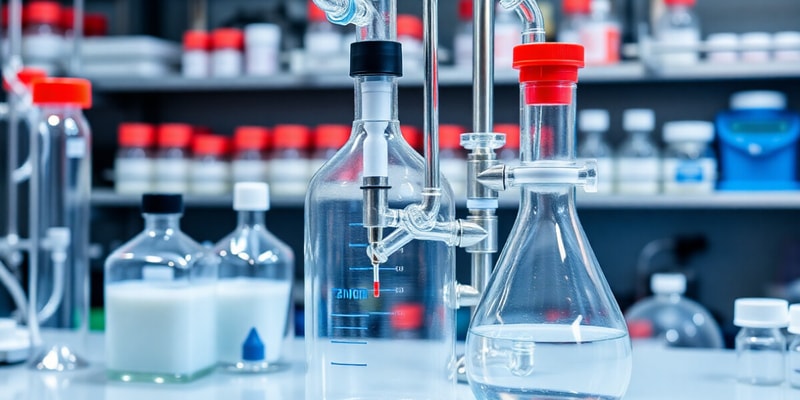Podcast
Questions and Answers
What is a dosage formulation in the context of thermodynamics?
What is a dosage formulation in the context of thermodynamics?
A dosage formulation is a system of multiple phases and components governed by thermodynamics and process equilibria.
Define the terms 'system' and 'surroundings' in thermodynamics.
Define the terms 'system' and 'surroundings' in thermodynamics.
A system is the defined part of the physical world under study, while the surroundings encompass the rest of the physical world affected by changes to the system.
What is the primary role of Active Pharmaceutical Ingredients (APIs) in pharmaceutical formulations?
What is the primary role of Active Pharmaceutical Ingredients (APIs) in pharmaceutical formulations?
APIs serve as the active drug molecules that provide the therapeutic effect in pharmaceuticals.
Explain the First Law of Thermodynamics in the context of pharmaceutical systems.
Explain the First Law of Thermodynamics in the context of pharmaceutical systems.
Signup and view all the answers
How do equilibrium processes relate to pharmacological activity?
How do equilibrium processes relate to pharmacological activity?
Signup and view all the answers
Define chemical potential and its significance in pharmaceutical systems.
Define chemical potential and its significance in pharmaceutical systems.
Signup and view all the answers
Describe the role of chromatography in pharmaceutical analysis.
Describe the role of chromatography in pharmaceutical analysis.
Signup and view all the answers
What is meant by 'phases' in the context of a pharmaceutical system?
What is meant by 'phases' in the context of a pharmaceutical system?
Signup and view all the answers
What is the purpose of the Henderson-Hasselbalch equation in pharmaceuticals?
What is the purpose of the Henderson-Hasselbalch equation in pharmaceuticals?
Signup and view all the answers
How do phase diagrams contribute to the development of pharmaceutical formulations?
How do phase diagrams contribute to the development of pharmaceutical formulations?
Signup and view all the answers
What is the significance of enthalpy in thermodynamics related to pharmaceuticals?
What is the significance of enthalpy in thermodynamics related to pharmaceuticals?
Signup and view all the answers
Explain the relationship between thermodynamics and the manufacturing of Active Pharmaceutical Ingredients (APIs).
Explain the relationship between thermodynamics and the manufacturing of Active Pharmaceutical Ingredients (APIs).
Signup and view all the answers
Describe the significance of entropy in the context of drug stability.
Describe the significance of entropy in the context of drug stability.
Signup and view all the answers
List two examples of equilibrium processes relevant in medicinal applications.
List two examples of equilibrium processes relevant in medicinal applications.
Signup and view all the answers
What are polymorphs, and why are they important in pharmacy?
What are polymorphs, and why are they important in pharmacy?
Signup and view all the answers
What role does thermal analysis play in pharmaceutical study?
What role does thermal analysis play in pharmaceutical study?
Signup and view all the answers
Explain how ionic strength affects the activity of drugs in solutions.
Explain how ionic strength affects the activity of drugs in solutions.
Signup and view all the answers
What do eutectic points signify in a phase diagram?
What do eutectic points signify in a phase diagram?
Signup and view all the answers
Describe how thermodynamics influences drug formulation processes.
Describe how thermodynamics influences drug formulation processes.
Signup and view all the answers
Discuss the impact of free energy on drug binding to receptors.
Discuss the impact of free energy on drug binding to receptors.
Signup and view all the answers
What is the significance of the law of mass action in establishing equilibrium constants?
What is the significance of the law of mass action in establishing equilibrium constants?
Signup and view all the answers
In a pharmaceutical context, how does a drug's partitioning between aqueous and lipid phases affect its bioavailability?
In a pharmaceutical context, how does a drug's partitioning between aqueous and lipid phases affect its bioavailability?
Signup and view all the answers
What does it mean for a system to be in dynamic equilibrium?
What does it mean for a system to be in dynamic equilibrium?
Signup and view all the answers
List two examples of phases that can interact in drug formulations.
List two examples of phases that can interact in drug formulations.
Signup and view all the answers
How can stoichiometries a, b, c, d affect the equilibrium constant (Keq)?
How can stoichiometries a, b, c, d affect the equilibrium constant (Keq)?
Signup and view all the answers
Why is it important to measure the concentrations of both the aqueous and lipid phases in drug studies?
Why is it important to measure the concentrations of both the aqueous and lipid phases in drug studies?
Signup and view all the answers
Describe the role of the equilibrium constant (Keq) in a pharmaceutical process involving drug partitioning.
Describe the role of the equilibrium constant (Keq) in a pharmaceutical process involving drug partitioning.
Signup and view all the answers
What happens to the concentrations of components A and B at equilibrium in a reversible reaction?
What happens to the concentrations of components A and B at equilibrium in a reversible reaction?
Signup and view all the answers
Explain how immiscible liquids can create challenges in drug formulation.
Explain how immiscible liquids can create challenges in drug formulation.
Signup and view all the answers
In pharmacology, why is it important to understand the relationship between C and D when they react to form A and B?
In pharmacology, why is it important to understand the relationship between C and D when they react to form A and B?
Signup and view all the answers
How is the equilibrium constant (Keq) for a reaction calculated?
How is the equilibrium constant (Keq) for a reaction calculated?
Signup and view all the answers
What does a high value of Keq indicate about a reaction's products and reactants?
What does a high value of Keq indicate about a reaction's products and reactants?
Signup and view all the answers
In the isomerization of G6P to F6P with an initial G6P concentration of 0.1 M and Keq of 0.428, what is the relationship established for [F6P]?
In the isomerization of G6P to F6P with an initial G6P concentration of 0.1 M and Keq of 0.428, what is the relationship established for [F6P]?
Signup and view all the answers
Given the initial concentration of G3P at 0.05 M and its equilibrium concentration at 0.002 M, calculate Keq.
Given the initial concentration of G3P at 0.05 M and its equilibrium concentration at 0.002 M, calculate Keq.
Signup and view all the answers
What is the significance of the partition coefficient (P) in biochemical reactions?
What is the significance of the partition coefficient (P) in biochemical reactions?
Signup and view all the answers
How does temperature affect the equilibrium constant Keq for a reaction?
How does temperature affect the equilibrium constant Keq for a reaction?
Signup and view all the answers
Why is it important to understand the structure and stability of pharmaceutical systems?
Why is it important to understand the structure and stability of pharmaceutical systems?
Signup and view all the answers
What does it mean when the equilibrium constant is inverted for a reverse process?
What does it mean when the equilibrium constant is inverted for a reverse process?
Signup and view all the answers
Define the term 'isomerase' in the context of biochemical reactions.
Define the term 'isomerase' in the context of biochemical reactions.
Signup and view all the answers
Describe the significance of equilibrium in biochemical processes.
Describe the significance of equilibrium in biochemical processes.
Signup and view all the answers
Study Notes
PF1010: Physicochemical Basis of Pharmaceuticals
- Objective: Introduces physicochemical principles in pharmaceutical systems.
-
Focuses on:
- Pharmaceutical Systems: Formulations of APIs and excipients, drugs binding to receptors, enzymes binding substrates, cellular structures.
- Physicochemical Principles: Chemistry, physics, and physical chemistry that influence the structure, stability, and function of pharmaceutical systems.
-
Course Materials: Available on Canvas → 2025-PF1010
- PDFs of lecture slides, tutorial question slides, and answers
- Recordings of lectures (if possible).
-
Textbooks:
- Entry Level: Any 3rd level general chemistry textbook (e.g., ‘Chemistry’, C.E.Housecroft & E.C.Constable) or Principles and problems in physical chemistry for biochemists, Price & Dwek
- Intermediate: Pharmaceutics; The Science of Dosage Form Design, Aulton (Ed.)
- Advanced: Physical Pharmacy and Pharmaceutical Science, Martin or Physical Chemistry, Atkins & de Paula
- Topic Coverage: Introduction to Thermodynamics (equilibrium, ideal gases, first law of thermodynamics, enthalpy, thermochemistry, second law of thermodynamics, entropy, free energy, chemical potential, the phase rule, phase diagrams, triple and critical points), systems of one, two, three components, eutectic points, triangular phase diagrams, systems with multiple solid phases, polymorphs and solvates, acids & bases, pH, pKa, Henderson-Hasselbalch equations, activity, and ionic strength.
Thermodynamics in Pharmaceuticals
-
Pharmaceuticals and Thermodynamics: Dosage formulations, like medicines, are systems of multiple phases and components governed by thermodynamics and process equilibria.
- System: A defined part of the physical world under study.
- Phase: A homogeneous portion of physical material bounded by interfaces.
- Component: A chemical 'ingredient' of the system.
- Pharmaceutical Examples:
- Binding of drugs to receptors or enzymes.
- Biochemical reactions in body metabolism.
- Processes for manufacturing Active Pharmaceutical Ingredients (APIs).
- Many formulation processes.
- Most measures of pharmacological activity are, effectively, equilibrium constants.
Pharmaceutical Analysis
- Pharmaceutical analysis relies on quantitative measurement of:
- Partitioning between Phases: Chromatography (e.g., gas chromatography, TLC, HPLC).
- Enthalpy (Heat) Transfers: Thermal Analysis.
- Other Quantitative Physical Effects: Spectroscopy.
System and Surroundings
- System: The defined part of the physical world under study.
- Surroundings: The rest of the physical world, or at least the part affected by changes to the system.
Equilibrium in Pharmaceutical Systems
- Pharmaceutical systems may consist of many components and phases (e.g., components: API, excipients; phases: solid phase, immiscible liquids, gaseous phases).
- Components can be partitioned between various phases.
- The system (phases & components) exists in dynamic equilibrium.
Law of Mass Action & Equilibrium Constants
- Law of Mass Action: Governs equilibrium processes.
-
Example: For the reaction: aA + bB ⇌ cC + dD
- The equilibrium constant (Keq) is defined as: Keq = ([C]^c * [D]^d) / ([A]^a * [B]^b). [ ] represents concentration.
Examples of Pharmaceutical Processes and Equilibria
-
Drug Partitioning: Drug partitioned between an aqueous medium (e.g., cell interior) and a lipid medium (e.g., cell membrane)
- Partition Coefficient (P): Keq = P = [drug]lipid / [drug]aq.
- Often expressed as log P.
-
Reaction Equilibria:
- Example: For the reaction: RSH + RSH + [H2] ⇌ RSSR + [H2]
- Keq = [RSSR * [H2]] / [RSH]^2.
Biochemical Reaction
-
Worked Problem: The concentration of a solution of G3P was initially 0.05 M. Isomerase was added, and the mixture came to equilibrium at 25 °C. The concentration of G3P was measured at 0.002 M. Calculate Keq for the reaction at 25 °C.
- Equilibrium Constant (Keq): Keq = [DHAP] / [G3P].
- Calculation: Keq = 0.048 M / 0.002 M = 24.
Structure and Stability of Pharmaceutical Systems
- Pharmaceutical Systems: Medicines (dosage formulations of APIs and excipients) and ligands & receptors, enzymes & substrates/inhibitors, etc.
- Chemical Components: APIs, excipients, and biomolecules.
- Phases: Solids, liquids, gases, and others.
- Key Issue: Structure and stability of the system.
Studying That Suits You
Use AI to generate personalized quizzes and flashcards to suit your learning preferences.
Related Documents
Description
This quiz covers the key concepts of physicochemical principles critical to pharmaceutical systems. It focuses on the interactions in drug formulations, stability, and function influenced by chemistry and physics. Ideal for students aiming to understand the foundational aspects of pharmaceuticals.




